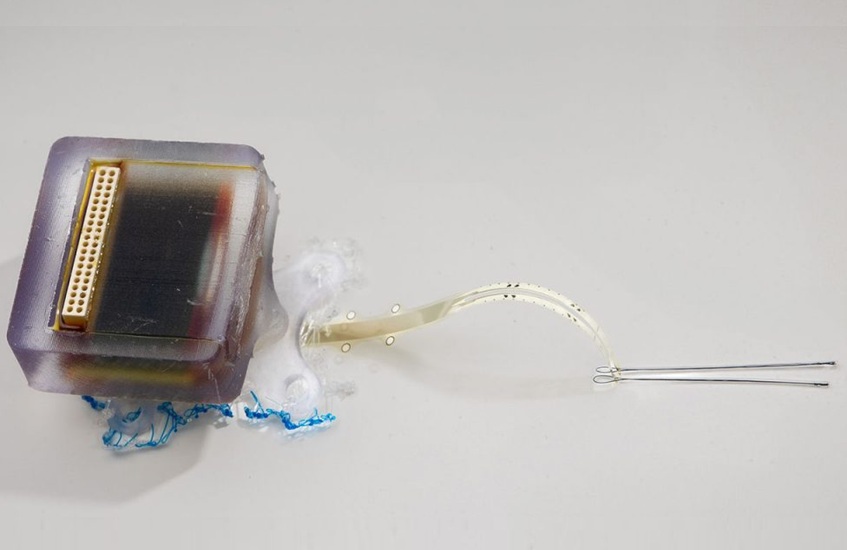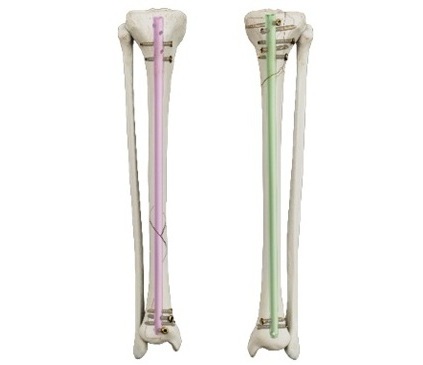Brain Abnormalities Revealed in Late Preterm Infants Using MRI
|
By HospiMedica International staff writers Posted on 17 Jun 2014 |

Image: (a) Axial T2-weighted image shows deep gray nuclei (DGN) width, anteroposterior (AP) distance, and surface area. (b) Coronal T2- weighted image shows lateral ventricle atrial measures and transverse cerebellar diameter (TCD) (Photo courtesy of the Radiological Society of North America).
Infants born 32 to 36 weeks into gestation may have smaller brains and other brain defects that could lead to long-term developmental difficulties, according to a new imaging study.
A lot of the existing information on preterm birth and brain development has been gathered from studies of individuals born very preterm, or less than 32 weeks into gestation at birth.
For the new study, published online June 2014 in the journal Radiology, researchers in Australia focused on moderate and late preterm (MLPT) infants—those born between 32 weeks, zero days, and 36 weeks, six days, into gestation. MLPT babies account for approximately 80% of all preterm births and are responsible for much of the rise in the rates of preterm births over the last 20 years. In spite of this, up to now there have been no large-scale studies published on brain alterations linked with MLPT births that may offer clues into brain-behavior relationships in this group of children.
“In those very preterm babies, brain injury from bleeding into the brain or a lack of blood flow, oxygen or nutrition to the brain may explain some of the abnormal brain development that occurs,” said the study’s lead author, Jennifer M. Walsh, MBBCh, BAO., MRCPI, from the Royal Women’s Hospital (Melbourne, Australia). “However, in some preterm babies, there may be no obvious explanation for why their brain development appears slow compared with babies born on time.”
The researchers performed magnetic resonance imaging (MRI) scanning on 199 MLPT and 50 full-term-born infants (greater than 37 weeks gestation) between 38 to 44 weeks of gestation. They searched for symptoms of brain injury and compared the size and maturation of multiple brain structures in the two groups. Whereas injury rates were similar between the two groups, MLPT births were tied to smaller brain size at full-term-equivalent age. Furthermore, MLPT infants had less developed myelination in one part of the brain and more immature gyral folding compared with full term-born controls.
The findings suggest that MLPT births may disrupt the predicted course of brain growth that would normally occur in the last two or so months in utero, according to Dr. Walsh. “Given that brain growth is very rapid in the last one-third of pregnancy, it is perhaps not surprising that being born during this potentially vulnerable period may disrupt brain development,” she said.
The researchers are hoping to better determine the impact that moderate to late preterm birth has on the brain, so that they can then begin to try different treatments designed to enhance brain function and long-term outcome in these infants. “Medications, along with early intervention to help parents understand their baby’s needs, have been effective in helping very preterm babies catch up to their term-born peers,” Dr. Walsh said. “However, whether any of the existing treatments will help babies born between 32 and 36 weeks is unknown, as they have not been studied very much at all.”
The researchers plan to follow the infants in the study group through childhood to learn more about the relationship between brain abnormalities and later outcomes. They also are evaluating additional MRI information about brain structure and function in these children. “Understanding what problems they have and what might be causing them is the first step in trying to improve their long-term outcome,” Dr. Walsh said.
Related Links:
Royal Women’s Hospital
A lot of the existing information on preterm birth and brain development has been gathered from studies of individuals born very preterm, or less than 32 weeks into gestation at birth.
For the new study, published online June 2014 in the journal Radiology, researchers in Australia focused on moderate and late preterm (MLPT) infants—those born between 32 weeks, zero days, and 36 weeks, six days, into gestation. MLPT babies account for approximately 80% of all preterm births and are responsible for much of the rise in the rates of preterm births over the last 20 years. In spite of this, up to now there have been no large-scale studies published on brain alterations linked with MLPT births that may offer clues into brain-behavior relationships in this group of children.
“In those very preterm babies, brain injury from bleeding into the brain or a lack of blood flow, oxygen or nutrition to the brain may explain some of the abnormal brain development that occurs,” said the study’s lead author, Jennifer M. Walsh, MBBCh, BAO., MRCPI, from the Royal Women’s Hospital (Melbourne, Australia). “However, in some preterm babies, there may be no obvious explanation for why their brain development appears slow compared with babies born on time.”
The researchers performed magnetic resonance imaging (MRI) scanning on 199 MLPT and 50 full-term-born infants (greater than 37 weeks gestation) between 38 to 44 weeks of gestation. They searched for symptoms of brain injury and compared the size and maturation of multiple brain structures in the two groups. Whereas injury rates were similar between the two groups, MLPT births were tied to smaller brain size at full-term-equivalent age. Furthermore, MLPT infants had less developed myelination in one part of the brain and more immature gyral folding compared with full term-born controls.
The findings suggest that MLPT births may disrupt the predicted course of brain growth that would normally occur in the last two or so months in utero, according to Dr. Walsh. “Given that brain growth is very rapid in the last one-third of pregnancy, it is perhaps not surprising that being born during this potentially vulnerable period may disrupt brain development,” she said.
The researchers are hoping to better determine the impact that moderate to late preterm birth has on the brain, so that they can then begin to try different treatments designed to enhance brain function and long-term outcome in these infants. “Medications, along with early intervention to help parents understand their baby’s needs, have been effective in helping very preterm babies catch up to their term-born peers,” Dr. Walsh said. “However, whether any of the existing treatments will help babies born between 32 and 36 weeks is unknown, as they have not been studied very much at all.”
The researchers plan to follow the infants in the study group through childhood to learn more about the relationship between brain abnormalities and later outcomes. They also are evaluating additional MRI information about brain structure and function in these children. “Understanding what problems they have and what might be causing them is the first step in trying to improve their long-term outcome,” Dr. Walsh said.
Related Links:
Royal Women’s Hospital
Latest Critical Care News
- Smart Capsule Offers Real-Time Profiling Across GI Tract
- Ultra-Thin Implant Helps Patients with Spinal Cord Injury Recover Lost Functions
- Portable Cell Therapy Device to Enable Rapid On-Demand Modification of RBCs at POC
- Monitoring Airborne Fungal Spores Could Help Predict COVID-19 & Flu Surges
- New System Measures Blood Sodium Without Needles
- Sleep Data from Wearable Device May Help Predict Preterm Birth
- AI Tool Interprets Echocardiograms in Minutes
- Electrochemical Catheter Hub Prevents Bloodstream Infections
- Noninvasive Double Microbubble Delivery Approach Marks Breakthrough in Brain Cancer Treatment
- Self-Healing Skin-Like Material to Find Applications in Health Monitoring, Surgery and Implants
- Highly-Sensitive Electronic Skin Allows Robots to Feel Heat, Pain and Pressure

- AI-Powered Wearable Sensor Predicts Labor Onset in Pregnant Women
- Implantable Device to Redefine Continuous Glucose Monitoring
- Smart Microgel Could Repair and Replace Damaged Organs
- Smart Breath Tracker Wristband to Revolutionize Respiratory Care
- Stronger Blood Clot Prevention Measures Needed After Leg Artery Procedures in High-Risk Patients
Channels
Critical Care
view channel
Ultra-Thin Implant Helps Patients with Spinal Cord Injury Recover Lost Functions
Spinal cord injuries remain incurable and can have life-altering consequences. These injuries disrupt the communication pathway between the brain and the body, often leading to permanent loss of function.... Read more
Smart Capsule Offers Real-Time Profiling Across GI Tract
Researchers are increasingly recognizing the gastrointestinal (GI) tract as a key player in overall health. While its primary role is in digestion, the GI tract also contributes to the production of hormones,... Read moreSurgical Techniques
view channel
First-Ever Technology Makes Blood Translucent During Surgery
No matter the discipline or scale, bleeding is a regular part of any surgery and can create several challenges. In operating room imaging, seeing through blood in real-time during a surgery has been a... Read more
Tibia Nailing System with Novel Side-Specific Nails to Revolutionize Fracture Surgery
Smith+Nephew (Hull, UK;) has launched its new TRIGEN MAX Tibia Nailing System for stable and unstable fractures of the tibia, including the shaft. It is the only system to now offer trauma surgeons the... Read morePatient Care
view channel
Revolutionary Automatic IV-Line Flushing Device to Enhance Infusion Care
More than 80% of in-hospital patients receive intravenous (IV) therapy. Every dose of IV medicine delivered in a small volume (<250 mL) infusion bag should be followed by subsequent flushing to ensure... Read more
VR Training Tool Combats Contamination of Portable Medical Equipment
Healthcare-associated infections (HAIs) impact one in every 31 patients, cause nearly 100,000 deaths each year, and cost USD 28.4 billion in direct medical expenses. Notably, up to 75% of these infections... Read more
Portable Biosensor Platform to Reduce Hospital-Acquired Infections
Approximately 4 million patients in the European Union acquire healthcare-associated infections (HAIs) or nosocomial infections each year, with around 37,000 deaths directly resulting from these infections,... Read moreFirst-Of-Its-Kind Portable Germicidal Light Technology Disinfects High-Touch Clinical Surfaces in Seconds
Reducing healthcare-acquired infections (HAIs) remains a pressing issue within global healthcare systems. In the United States alone, 1.7 million patients contract HAIs annually, leading to approximately... Read moreHealth IT
view channel
Printable Molecule-Selective Nanoparticles Enable Mass Production of Wearable Biosensors
The future of medicine is likely to focus on the personalization of healthcare—understanding exactly what an individual requires and delivering the appropriate combination of nutrients, metabolites, and... Read more
Smartwatches Could Detect Congestive Heart Failure
Diagnosing congestive heart failure (CHF) typically requires expensive and time-consuming imaging techniques like echocardiography, also known as cardiac ultrasound. Previously, detecting CHF by analyzing... Read moreBusiness
view channel
Bayer and Broad Institute Extend Research Collaboration to Develop New Cardiovascular Therapies
A research collaboration will focus on the joint discovery of novel therapeutic approaches based on findings in human genomics research related to cardiovascular diseases. Bayer (Berlin, Germany) and... Read more



















